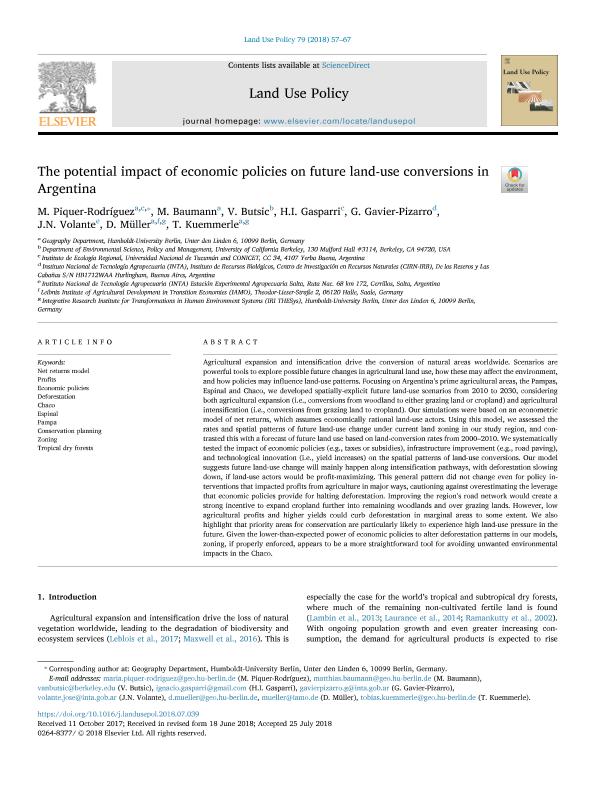Mostrar el registro sencillo del ítem
dc.contributor.author
Piquer Rodríguez, María

dc.contributor.author
Baumann, Matthias

dc.contributor.author
Butsic, Van

dc.contributor.author
Gasparri, Nestor Ignacio

dc.contributor.author
Gavier Pizarro, Gregorio

dc.contributor.author
Volante, José Norberto

dc.contributor.author
Müller, Daniel

dc.contributor.author
Kuemmerle, Tobias

dc.date.available
2019-11-25T23:37:02Z
dc.date.issued
2018-12
dc.identifier.citation
Piquer Rodríguez, María; Baumann, Matthias; Butsic, Van; Gasparri, Nestor Ignacio; Gavier Pizarro, Gregorio; et al.; The potential impact of economic policies on future land-use conversions in Argentina; Pergamon; Land Use Policy; 79; 12-2018; 57-67
dc.identifier.issn
0264-8377
dc.identifier.uri
http://hdl.handle.net/11336/90420
dc.description.abstract
Agricultural expansion and intensification drive the conversion of natural areas worldwide. Scenarios are powerful tools to explore possible future changes in agricultural land use, how these may affect the environment, and how policies may influence land-use patterns. Focusing on Argentina's prime agricultural areas, the Pampas, Espinal and Chaco, we developed spatially-explicit future land-use scenarios from 2010 to 2030, considering both agricultural expansion (i.e., conversions from woodland to either grazing land or cropland) and agricultural intensification (i.e., conversions from grazing land to cropland). Our simulations were based on an econometric model of net returns, which assumes economically rational land-use actors. Using this model, we assessed the rates and spatial patterns of future land-use change under current land zoning in our study region, and contrasted this with a forecast of future land use based on land-conversion rates from 2000–2010. We systematically tested the impact of economic policies (e.g., taxes or subsidies), infrastructure improvement (e.g., road paving), and technological innovation (i.e., yield increases) on the spatial patterns of land-use conversions. Our model suggests future land-use change will mainly happen along intensification pathways, with deforestation slowing down, if land-use actors would be profit-maximizing. This general pattern did not change even for policy interventions that impacted profits from agriculture in major ways, cautioning against overestimating the leverage that economic policies provide for halting deforestation. Improving the region's road network would create a strong incentive to expand cropland further into remaining woodlands and over grazing lands. However, low agricultural profits and higher yields could curb deforestation in marginal areas to some extent. We also highlight that priority areas for conservation are particularly likely to experience high land-use pressure in the future. Given the lower-than-expected power of economic policies to alter deforestation patterns in our models, zoning, if properly enforced, appears to be a more straightforward tool for avoiding unwanted environmental impacts in the Chaco.
dc.format
application/pdf
dc.language.iso
eng
dc.publisher
Pergamon

dc.rights
info:eu-repo/semantics/openAccess
dc.rights
Atribución-NoComercial-CompartirIgual 2.5 Argentina (CC BY-NC-SA 2.5 AR)
dc.rights.uri
https://creativecommons.org/licenses/by-nc-sa/2.5/ar/
dc.subject
CHACO
dc.subject
CONSERVATION PLANNING
dc.subject
DEFORESTATION
dc.subject
ECONOMIC POLICIES
dc.subject
ESPINAL
dc.subject
NET RETURNS MODEL
dc.subject
PAMPA
dc.subject
PROFITS
dc.subject
TROPICAL DRY FORESTS
dc.subject
ZONING
dc.subject.classification
Ciencias Medioambientales

dc.subject.classification
Ciencias de la Tierra y relacionadas con el Medio Ambiente

dc.subject.classification
CIENCIAS NATURALES Y EXACTAS

dc.subject.classification
Otras Geografía Económica y Social

dc.subject.classification
Geografía Económica y Social

dc.subject.classification
CIENCIAS SOCIALES

dc.title
The potential impact of economic policies on future land-use conversions in Argentina
dc.type
info:eu-repo/semantics/article
dc.type
info:ar-repo/semantics/artículo
dc.type
info:eu-repo/semantics/publishedVersion
dc.date.updated
2019-10-16T20:58:22Z
dc.journal.volume
79
dc.journal.pagination
57-67
dc.journal.pais
Reino Unido

dc.journal.ciudad
Oxford
dc.description.fil
Fil: Piquer Rodríguez, María. Universidad Nacional de Tucumán. Instituto de Ecología Regional. Consejo Nacional de Investigaciones Científicas y Técnicas. Centro Científico Tecnológico Conicet - Tucumán. Instituto de Ecología Regional; Argentina. Universität zu Berlin; Alemania
dc.description.fil
Fil: Baumann, Matthias. Universität zu Berlin; Alemania
dc.description.fil
Fil: Butsic, Van. University of California at Berkeley; Estados Unidos
dc.description.fil
Fil: Gasparri, Nestor Ignacio. Universidad Nacional de Tucumán. Instituto de Ecología Regional. Consejo Nacional de Investigaciones Científicas y Técnicas. Centro Científico Tecnológico Conicet - Tucumán. Instituto de Ecología Regional; Argentina
dc.description.fil
Fil: Gavier Pizarro, Gregorio. Consejo Nacional de Investigaciones Científicas y Técnicas; Argentina. Instituto Nacional de Tecnología Agropecuaria. Centro de Investigación de Recursos Naturales. Instituto de Recursos Biológicos; Argentina
dc.description.fil
Fil: Volante, José Norberto. Instituto Nacional de Tecnología Agropecuaria. Centro Regional Salta. Estación Experimental Agropecuaria Salta; Argentina
dc.description.fil
Fil: Müller, Daniel. Universität zu Berlin; Alemania. Leibniz Institute of Agricultural Development in Transition Economies; Alemania
dc.description.fil
Fil: Kuemmerle, Tobias. Universität zu Berlin; Alemania
dc.journal.title
Land Use Policy

dc.relation.alternativeid
info:eu-repo/semantics/altIdentifier/doi/http://dx.doi.org/10.1016/j.landusepol.2018.07.039
dc.relation.alternativeid
info:eu-repo/semantics/altIdentifier/url/https://www.sciencedirect.com/science/article/pii/S0264837717313145
Archivos asociados
